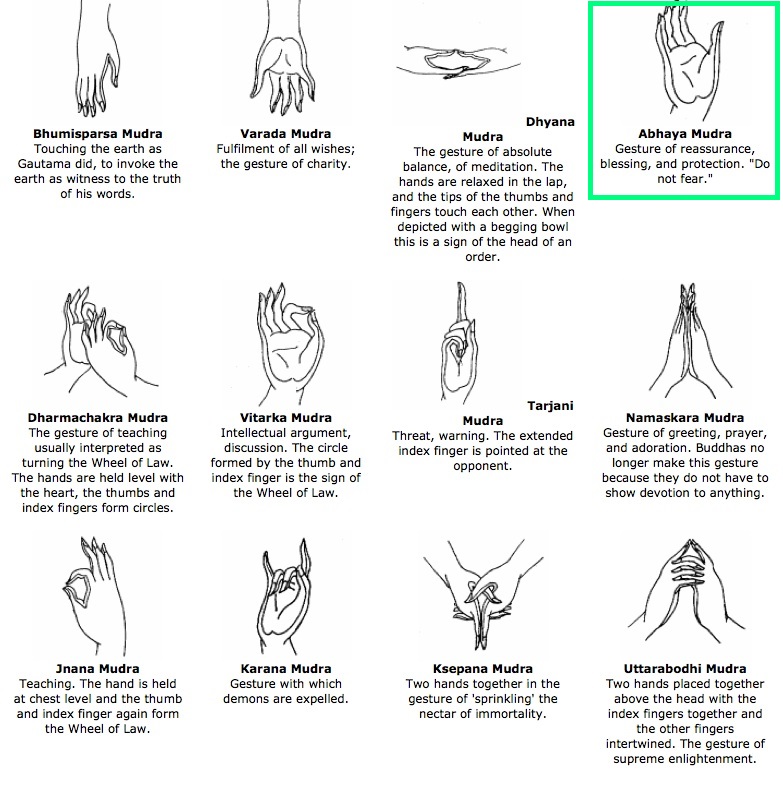From UPSC perspective, the following things are important :
Prelims level: Various mudras of Buddha
Why in the News?
The Leader of Opposition invoked the Abhaya Mudra in his inaugural address as Leader of Opposition in Lok Sabha.
What is Abhay Mudra?
- Abhaya mudra, the motif of an open palm (gesturing to stop), is prevalent across many South Asian religions, including Hinduism, Buddhism, Jainism, and Sikhism.
- Known as the ‘fearlessness gesture’, ‘abhaya’ in Sanskrit means fearlessness. The gesture symbolizes protection and peace.
- In yoga circles, the abhaya mudra is believed to promote courage and reduce fear and anxiety.
- While common across many religions, the abhaya mudra is most prominently featured in Buddhism, especially in Thailand and Laos, where it is associated with images of the walking Buddha.
Origins of the Gesture
- According to Stanford University, the gesture of an open palm pointed outwards appears to be a natural gesture used since prehistoric times as a sign of good intentions and peace.
- The gesture also asserted power in antiquity, similar to the magna manus of the Roman Emperors who legislated and gave peace simultaneously.
- The motif likely originated from a universal gesture associated with human communication, eventually integrating into major South Asian religions.
Evolution of Mudras in Buddhism
- For about 500 years after the Buddha, he was not depicted in physical form.
- Early representations appeared around the first millennium, influenced by Gandhara and Gupta art.
- With the evolution of these Buddhist traditions, hundreds of mudras entered Buddhist iconography.
- In tantric Buddhist traditions, mudras symbolized material offerings, enacted forms of worship, or relationships with visualized deities. (as shown in the above diagram)
Significance of ‘Abhaya Mudra’ in Buddhism:
- In Buddhism, the abhaya mudra is linked to a legend involving Devadatta, a cousin of the Buddha, who tried to murder the Buddha by losing a rampaging elephant into his path.
- The Buddha calmed the elephant by displaying the abhaya mudra, indicating appeasement of the senses and the absence of fear.
- The gesture is popularly pronounced in Buddhist cultures, symbolizing fearlessness and peace.
Significance of ‘Abhaya Mudra’ in Hindu Religion:
- The Buddha was absorbed into the Hindu pantheon as the 9th incarnation of Vishnu.
- Hindus regarded the Buddha as an avatar of Vishnu between AD 450 and the sixth century, with the first mention in the Vishnu Purana (400-500 CE).
- The abhaya mudra appears in depictions of Hindu deities, commonly seen in images of Lord Shiva, Lord Vishnu, and Lord Ganesha.
PYQ:[2014] Lord Buddha’s image is sometimes shown with a hand gesture called ‘Bhumisparsha Mudra’. It symbolizes: (a) Buddha’s calling of the Earth to watch over Mara and to prevent Mara from disturbing his meditation (b) Buddha’s calling of the Earth to witness his purity and chastity despite the temptations of Mara (c) Buddha’s reminder to his followers that they all arise from the Earth and finally dissolve into the Earth and thus this life is transitory (d) Both the statements ‘a’ and ‘b’ are correct in this context [2014] Gandhara sculpture owed as much to the Romans as to the Greeks. Explain. [2016] Early Buddhist Stupa-art, while depicting folk motifs and narratives, successfully expounds Buddhist ideals. Elucidate. |
Get an IAS/IPS ranker as your 1: 1 personal mentor for UPSC 2024


